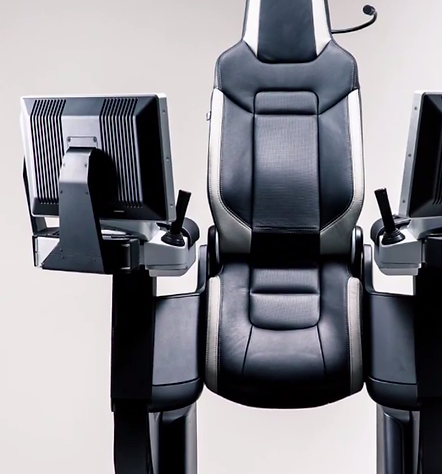RISE sit / stand workstation
2016
The RISE sit / stand workstation is designed to integrate large workstation control packages in a posture variable chair, including ergonomic adjusments for 5 to 95 percentile users
Responsible for:
-
Concept and design
-
Mechanical design
-
Prototypes and testing
-
Production transfer
Operator chairs are used for long work shifts, between 8 to 12 hours depending on installation.
Prolonged seated working posture comes with risk for sciatica and circulation issues, therefore it is recommended that the workstation can easily adapt to sitting and standing postures when desired by the user.


Sciatic nerve. Pain and numbness from prolonged seated position are often caused by nerves or blood vessels put under pressure between the body and the cushion.
Innovations
Aside from ergonomics, a heavily integrated workstation has to:
-
Provide management for large amounts of cabling, HMI's and control modules
-
Maintain structural stability and strength while subjected cabin vibrations and dynamic loads from heavy users, sometimes weighing over 300 lbs
-
Output enough actuation force to change size and posture configurations when heavy users are sitting in the chair
-
Maintain user safety from pinching, crushing and other hazards
These requirements were solved in the design of the SIT / STAND workstation, by coming up with innovations in actuation and sit/stand exoskeleton design in combination with the standard chair adjustment module.
The mechanical concept was awarded a patent in 2015. Patent no. 339533

Mechanical design
These illustrations show the difference in body dimensions from small 5 percentile to large 95 percentile users.
The joysticks and the floor level are the ergonomic anchor points for the design, everything between has to be adjustible in size.
A crucial part of the solution is that a typical ergonomic setting on the seated configuration does not change when rising up to standing position, minimizing adjustments when users alternate between sitting and standing throughout their work shift.
The parallel arm solution opens up for an innovative way to combine cheap linear actuators and cable protective chains in a compact design, allowing large movements while maintaining proper bending radii and actuation force.
Apart from removable access plates, the load bearing structure is also the designed exterior, using a combination of casted aluminium and plate metal





Inspired by the human body
Off-the shelf solutions for sit / stand workstations do not integrate well the mechanical requirements between structural strength, cable management, actuator build and hazard protection.
The main difficulty lies in achieving the large vertical change from the elbow height of small sitting users, and up to the elbow height of large standing users.
The traditional implementation of linear bearings, sliding protection covers, telescopic push actuators and cable chains is shown on the lower side, making apparent the downsides of this solution:
-
Linear bearings do not fit between floor level and elbow height, making it necessary to enter the volume below floor level. This severly impacts any swivel function below
-
Actuators working in 1:1 ratio with the movement need to be of the telescopic push type to fit. Push type actuators does not allow for balancing weight with springs and require for the actuator to lift 100% of user and product weight.
-
Cables chains have to move in a rolling U shape, which creates a used volume of (minimum) cable cross section x bending radius x 2 as shown.
-
Telescopic covers (removable) to protect users from pinch / squeeze create mechanical and design complexity while adding no structural value


The RISE sit / stand mechanism is inspired from the mechanical layout of the human body, by implementing a balanced system of springs and actuators that mimics the way the human body is balanced between tendons and muscles.
This way, gas springs carry as much of the user and system weight as is possible while still allowing the actuators to compress. The spring function both eliminates any play in the mechanical system and also allows for quicker actuators that push/pull with less force.
The humanoid movements also allow the cable management to bend to a very small degree compared to traditional cable carriers, so that the cables are subjected to small movements only when alternating between sitting and standing poses.

SIT / STAND CHAIR DEMONSTRATION
Worldwide users
When marketing a product worldwide, you have to accomodate a large variety of users, typically 90% of female and male users worldwide.
The variation in body dimensions worldwide can be significant, which creates special challenges when designing heavily integrated workstations that combines wide functionality with wide user accomodation.



Percentiles. ISO 7250 contains anthropometric data covering typical variations between worldwide users. The above numbers show how standing elbox height varies.